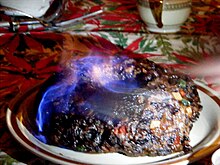Figgy pudding
 | |
| Type | Pudding |
|---|---|
| Place of origin | United Kingdom |
Figgy pudding or fig pudding is any of many medieval Christmas dishes, usually sweet or savory cakes containing honey, fruits and nuts. In later times, rum or other distilled alcohol was often added to enrich the fruitiness of the flavour.
Etymology
Medieval cooking commonly employed
Take Almaende blanched; grynde hem and drawe hem up with watr and wyne; quartr figs hole raisons. Cast þerto powdor gingr and hony clarified; seeþ it wel and salt it, and seve forth.[4] |
Take blanched almonds, grind them, mix with water and wine, quartered figs, whole raisins. Add in powdered ginger, clarified honey, boil it well and salt it, and serve.[5] |
| —The Forme of Cury recipe 118 |
The Middle English name had several spellings, including ffygey, fygeye, fygee, figge, and figee.[6][7][8] The latter is a 15th-century conflation with a French dish of fish and curds called figé, meaning "curdled" in Old French.[7][6][9] But it too came to mean a "figgy" dish, involving cooked figs, boiled in wine or otherwise.[7] A turn of the 15th century herbal has a recipe for figee:
Nym figes, & boille hem in wyn, & bray hem in a morter with lied bred; tempre hit vp with goud wyn / boille it / do therto good spicere, & hole resons / dresse hit / florisshe it a-boue with pomme-garnetes.[10] |
Take figs and boil them in wine, and pound them in a mortar with bread. Mix it up with good wine; boil it. Add good spices and whole raisins. Dress it; decorate it with pomegranate seeds on top.[11] |
| —Laudian Manuscript 553, Bodleian Library |
In popular culture
Often associated with the original traditions of Christmas, it is most notably referred to in the
See also
References
Cross-reference
- ^ a b Threlfall-Holmes 2005, p. 61–62.
- ^ a b Breverton 2015, p. 236.
- ^ Hieatt, Nutter & Holloway 2006, p. 113.
- ^ Pegge 2014, p. 45.
- ^ Albala 2006, p. 65.
- ^ a b c d Austin 1888, p. 129.
- ^ a b c Shipley 1955, p. 267.
- ^ a b c Hieatt, Nutter & Holloway 2006, p. 38.
- ^ Morton 2004, p. 51.
- ^ Austin 1888, p. 113.
- ^ Ayto 2012, p. 133.
- ^ Warner 1791, p. 67.
- ^ Beeton 2006, p. 618.
- ^ Cassidy 2004, p. 48.
Reference bibliography
- Albala, Ken (2006). "The Middle Ages 1300–1450". Cooking in Europe, 1250–1650. Daily life through history. Greenwood Publishing Group. ISSN 1080-4749.
- Ayto, John (2012). "figee". The Diner's Dictionary: Word Origins of Food and Drink. Oxford University Press. ISBN 9780199640249.
- Austin, Thomas (1888). Two Fifteenth-Century Cookery-Books. N. Trübner & Co. (Two Fifteenth-Century Cookery-Books at the Internet Archive)
- ISBN 9781840222685.
- ISBN 9781445648750.
- Cassidy, Jennie (December 2004). "Now bring us some figgy pudding!". Early Music Review. 104. King's Music. ISBN 9783761815946.
- ISBN 9780866983570.
- Morton, Mark (2004). "bouce Jane". Cupboard Love 2: A Dictionary of Culinary Curiosities. Insomniac Press. ISBN 9781897415931.
- Pegge, Samuel, ed. (2014). The Forme of Cury, a Roll of Ancient English Cookery. Cambridge University Press. ISBN 9781108076203.
- Shipley, Joseph T. (1955). "figee". Dictionary of Early English. Rowman & Littlefield. ISBN 9781442233997.
- Threlfall-Holmes, Miranda (2005). Monks and Markets: Durham Cathedral Priory 1460–1520. Oxford University Press. ISBN 9780199253814.
- Warner, Richard (1791). Antiquitates Culinariae, Or Curious Tracts Relating to the Culinary Affairs Of The Old English. London: R. Blamire.
